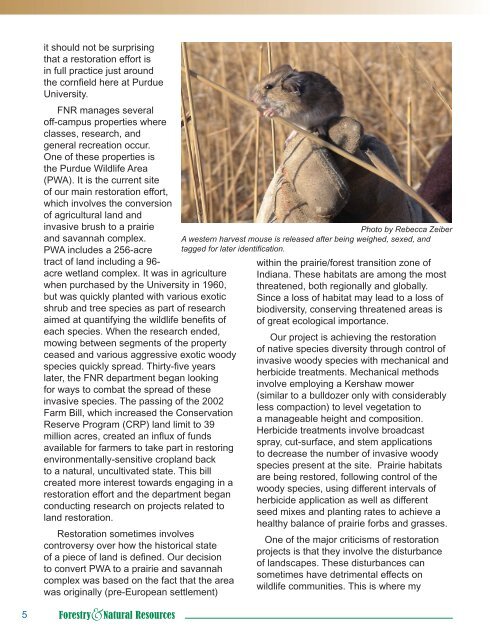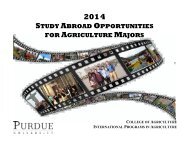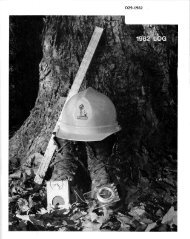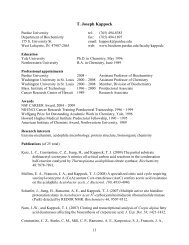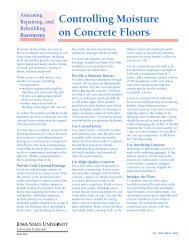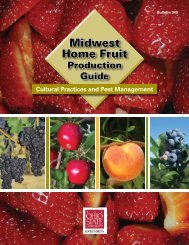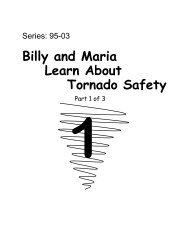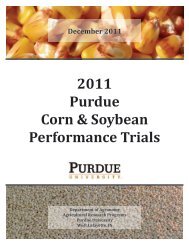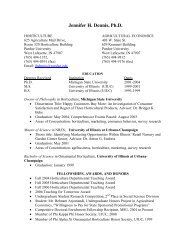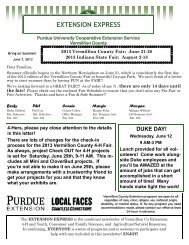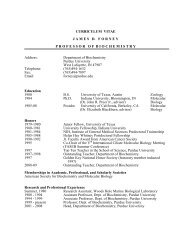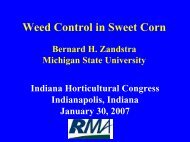Compass - Purdue Agriculture - Purdue University
Compass - Purdue Agriculture - Purdue University
Compass - Purdue Agriculture - Purdue University
- No tags were found...
Create successful ePaper yourself
Turn your PDF publications into a flip-book with our unique Google optimized e-Paper software.
it should not be surprisingthat a restoration effort isin full practice just aroundthe cornfield here at <strong>Purdue</strong><strong>University</strong>.FNR manages severaloff-campus properties whereclasses, research, andgeneral recreation occur.One of these properties isthe <strong>Purdue</strong> Wildlife Area(PWA). It is the current siteof our main restoration effort,which involves the conversionof agricultural land andinvasive brush to a prairieand savannah complex.PWA includes a 256-acretract of land including a 96-acre wetland complex. It was in agriculturewhen purchased by the <strong>University</strong> in 1960,but was quickly planted with various exoticshrub and tree species as part of researchaimed at quantifying the wildlife benefits ofeach species. When the research ended,mowing between segments of the propertyceased and various aggressive exotic woodyspecies quickly spread. Thirty-five yearslater, the FNR department began lookingfor ways to combat the spread of theseinvasive species. The passing of the 2002Farm Bill, which increased the ConservationReserve Program (CRP) land limit to 39million acres, created an influx of fundsavailable for farmers to take part in restoringenvironmentally-sensitive cropland backto a natural, uncultivated state. This billcreated more interest towards engaging in arestoration effort and the department beganconducting research on projects related toland restoration.Restoration sometimes involvescontroversy over how the historical stateof a piece of land is defined. Our decisionto convert PWA to a prairie and savannahcomplex was based on the fact that the areawas originally (pre-European settlement)Photo by Rebecca ZeiberA western harvest mouse is released after being weighed, sexed, andtagged for later identification.within the prairie/forest transition zone ofIndiana. These habitats are among the mostthreatened, both regionally and globally.Since a loss of habitat may lead to a loss ofbiodiversity, conserving threatened areas isof great ecological importance.Our project is achieving the restorationof native species diversity through control ofinvasive woody species with mechanical andherbicide treatments. Mechanical methodsinvolve employing a Kershaw mower(similar to a bulldozer only with considerablyless compaction) to level vegetation toa manageable height and composition.Herbicide treatments involve broadcastspray, cut-surface, and stem applicationsto decrease the number of invasive woodyspecies present at the site. Prairie habitatsare being restored, following control of thewoody species, using different intervals ofherbicide application as well as differentseed mixes and planting rates to achieve ahealthy balance of prairie forbs and grasses.One of the major criticisms of restorationprojects is that they involve the disturbanceof landscapes. These disturbances cansometimes have detrimental effects onwildlife communities. This is where my5


